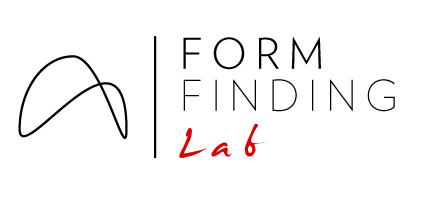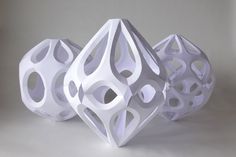Curved crease origami is a special type of origami which folds along curved creases instead of straight ones. Due to the curved creases, the paper bends while folding, resulting in complex and beautiful forms that can be used in engineering applications from cars to novel architectural structures.
It is no coincidence that the curved crease origami pioneer, David Huffman ,was also a computer scientist and his collaborator, Ron Resch, was both an artist and mathematician. Today, practice of curved crease origami has gone beyond being a craft and relies on geometric and numerical modelling, mathematics, non-linear mechanics but also most importantly on creativity.
Design Applications
A large subset of the research on curved crease folding focuses on approaches to find new curved crease forms. Designing curved crease origami is difficult due to the lack of mathematical, digital and analog methods for finding new forms. Noted by Koschitz, “we still have no general way to geometrically predict how an arbitrary curved crease folds in 3D” [2]. Without a complete mathematical understanding of curved crease folding, computational models are limited in their abilities for simulating creased objects. Consequently, improved computational modeling for interactive visualization of folded patterns is a hot area of research. One such approach is the origami simulator shown below.
http://apps.amandaghassaei.com/OrigamiSimulator/
These programs help the user interactively design and test their origami structures. However, in all the programs available, there is a large tradeoff between ease-of-use and the amount of information the program will tell. This tradeoff is mostly a product of how the program models the curved crease surface. Most programs use planar quadrangle meshes to approximate a curved surface. Although these programs have good performance while folding complex curves, they cannot accurately predict how the material between the folds will bend. The other set of programs uses finite element modeling, which allows for analysis of “the e ffect of the material properties and thickness , the design of the curved hinge, the boundary conditions and actuation, the stress concentrations and forces acting upon the structure and so on” [3]. However, they have reduced designing capabilities and demand an experienced user.
Engineering Applications
Due to the complex behavior of curved crease folding structures, advanced knowledge of material science and construction techniques are needed to turn a curved crease origami design into a functioning product. Additionally, understanding curved crease origami’s mechanical properties is central to any application. Current work with curved crease origami has been in the fields of architecture, space exploration, and manufacturing. By discussing a couple of current applications, I will highlight the main challenges for the implementation of these and future applications of curved crease folding engineered applications.
In architecture, curved crease folding has been used in adaptive shading elements. These structures are formed by an array of curved crease origami designs, connected to make a façade element. As the patterns fold, more light is allowed to pass through the façade, thereby adapting to the current outdoor environment. By controlling solar radiation and lighting levels, adaptive shading structures make buildings more energy efficient.
For systems that utilize multiple crease states (different amounts of folding), like the adaptive shading systems, actuation of many elements can be complex and costly. Further work needs to outline a method of actuation for patterns with multiple degrees of freedom. Doing so will expand the types of useable patterns past one degree of freedom patterns. Additionally, if stored energy in the bent structure could be utilized for actuation, this would reduce the energy required in the folding process. Current work in string actuated folded surfaces is a promising path for future research [4].
Another application of curved crease origami is for temporary, storable structures. Curved crease origami is conducive to lightweight, parametric designs that appear in designs such as the Undulatus research pavilion and Robofold’s category of work. These structures can be assembled on site, from sheets that are pre-creased. This reduces manufacturing cost and construction time.
However, there is a lack of knowledge around how many materials perform in curved crease folding structures. Design experiments with timber and steel have been done, but more materials need to be studied [5][6]. As work on self-folding structures continues to gain interest, knowledge of what materials can best fold and use their stored energy from bending will become increasingly important.
Despite these challenges for future researchers, curved crease origami has unique properties to be exploited. Compiled here is a list of these properties in order to showcase the potential advantages of curved crease folding.
- Actuation – structures can change shape dramatically and therefore can adapt to different environments (adaptive shading facades)
- Stored Energy – bending stores energy in the structure, which can be harnessed for actuation or structural integrity
- Deployability – depending on the crease pattern, the structure can fold and unfold into flat surfaces for storing or transporting. The prototype shown below is a thick membrane structure designed to pack efficiently into spacecraft and deploy in space [6].
- Fewer folds are required than straight crease folding, which reduces production time
- Low manufacturing costs because structures can be made as flat sheets [7]
https://ataleoftwosittings.wordpress.com/2014/12/20/five-guys/
- Beautiful form
Using these properties of curved crease folding as a starting point for designers and engineers will broaden the uses and potential of curved crease folding structures. Curved crease origami has been used in a diverse range of applications, from space flight to peanut containers. Future research can bring about a much wider range of applications.
Author: Aaron Lichtblau
Sources
1. Koschitz D, Demaine E, Demaine M, “Reconstructing David Huffman’s
Legacy in Curved-Crease Folding”.
2. Kosichtz D, “Digital and Analog Constraints Designing with Curved Creases” (2016).
3. Vergauwen A, De Temmerman N, De Laet L, “Digital modeling of deployable structures based on curved-line folding” (2014).
4. Kilian M, Monszpart A, Mitra N, et. al. “String Actuated Curved Folded Surfaces” (2017).
5. Buri H, “Curved Folded Plate Timber Structures”.
6. Eversmann P, Ihde A, EHRET André IHDE P, Zaha Hadid Architects e, “Curved-folding of thin aluminium plates: towards structural multi-panel shells” (2017).
7. Koschitz D, Demaine E, Demaine M, “Curved Crease Origami”.

